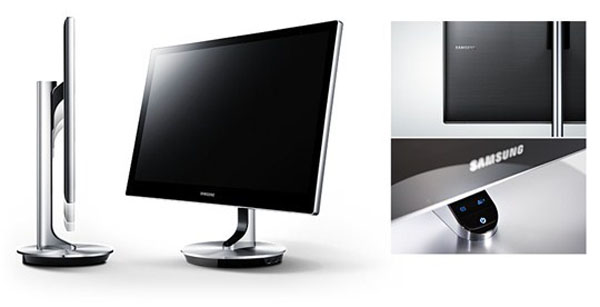Samsung S27B971D 27-Inch QHD Monitor, Reviewed
Samsung's S27B971D is a refreshed flagship 27-inch QHD monitor selling for $200 less than last-gen's model. It certainly looks impressive on paper, with its factory calibration and internal look-up table capability. Does it measure up in our lab, though?
New Monitor, New Price: Is The S27B971D A Better Value?
Most of us don't upgrade our monitors very often. If you already own an S27B970D, there is nothing about the newer model that warrants shelling out another $1000. The two main improvements are that contrast, while lower, is more consistent, and the screen’s new anti-glare layer is vastly superior to the old one.
If you’re still shopping for your first 27-inch QHD screen, however, Samsung does offer a few reasons to spend more on its new flagship instead of the competition's best efforts.
Performance is this display's top strength. Its accuracy is second to none. The benchmark results for grayscale, gamma, and color are either the best we've ever recorded or close to them. The only metric where the S27B971D falls short is contrast. But that story requires a deeper analysis. Yes, the raw contrast numbers are lower than some less expensive QHD screens (and even Samsung’s own S27B970D). But overall contrast performance is now much more consistent at all brightness levels. You can set the backlight control anywhere in its range and you’ll see around a 700-to-1 contrast ratio, both on/off and intra-image. Look over the other monitors' numbers, and you'll find that it's rare for a display to maintain its ratio so steadily in every scenario.
The only caveat is that you really need to calibrate in order to achieve peak performance. Samsung advertises a factory calibration and includes a data sheet along with each monitor showing impressive results. Our measurements did not correspond to those figures right out of the box, though. And so, without your intervention, the S27B971D is not significantly better than other QHD displays. It falls within reasonable parameters; errors are barely visible. But for $1000, we expected more accurate results.
We’re finding more monitors at lower price points that offer solid performance without calibration. And paying more doesn’t guarantee greater accuracy, either. You will always get the most out of your display with calibration. But if you don’t invest in the software and instruments, there are value-oriented choices out there too. This is not one of those options.
Samsung aims the S27B971D at professional users. We think it will appeal more to luxury-oriented buyers who attach equal importance to aesthetics as they do to performance. The most likely deal-breaker for Samsung's target market is the lack of a wide-gamut option. Now that Asus includes that feature in its PA279Q, manufacturers without it are at a disadvantage. We applaud Samsung’s price drop compared to last-gen's model. However, the company could still do a better job of improving value.
We hope that the 27-inch QHD segment is hit by a price drop soon. Cost reductions for LCD panels in general have slowed considerably in the past year. But now that the entire Tom's Hardware team is using displays with high pixel densities, we have no intention of stepping back to 1920x1080. Perhaps the inevitable ramp-up of 4K displays will knock QHD down a bit. For now, it remains predominantly high-end tech at a high-end price.
Get Tom's Hardware's best news and in-depth reviews, straight to your inbox.
Current page: New Monitor, New Price: Is The S27B971D A Better Value?
Prev Page Results: Pixel Response And Input Lag
Christian Eberle is a Contributing Editor for Tom's Hardware US. He's a veteran reviewer of A/V equipment, specializing in monitors. Christian began his obsession with tech when he built his first PC in 1991, a 286 running DOS 3.0 at a blazing 12MHz. In 2006, he undertook training from the Imaging Science Foundation in video calibration and testing and thus started a passion for precise imaging that persists to this day. He is also a professional musician with a degree from the New England Conservatory as a classical bassoonist which he used to good effect as a performer with the West Point Army Band from 1987 to 2013. He enjoys watching movies and listening to high-end audio in his custom-built home theater and can be seen riding trails near his home on a race-ready ICE VTX recumbent trike. Christian enjoys the endless summer in Florida where he lives with his wife and Chihuahua and plays with orchestras around the state.
-
cats_Paw 1000 dollars for a monitor 27 inch... nah.For that you can get a huge plasma TV if its for single player or a 300 dollar 27 inch monitor and use the 700 on something else.I still cant understand how companies expect to sell those expensive monitors to anyone but art/graphics/textures developers who actually need that picture quality.Reply -
c123456 @damianrobertjones: Do you know what comparable products cost? Apparently not. Look up a Dell U2713HM.Reply -
ubercake Contrast (even post-calibration) blows for that price. But you get a cool partially metal stand (?).Reply -
BoC_Gryphon To my knowledge, Toms has never done a review of the Korean 27" QHD monitors that can be had for ~$300-400. Please do.Reply -
Bolts Romano is it better than Apple Cinema Display in terms of color gamut and contrast?I wish i can find this monitor here in Canada so i can compare myselfSamsung Canada is very weird, it has its own flag stores here but it does not carry all the productsReply -
Bondfc11 You know this a pay to play for a review right? Of course Tom's doesn't do the korean models - or heck the Overlord Tempest lineup. What people don't get with QHD, and this includes Tom's staff, is LG has strict Tier 1 requirements for companies buying their panels that include minimum price points.Reply -
ceberle http://www.tomshardware.com/reviews/auria-eq276w-review-ips,3465.htmlReply
We covered the Auria EQ276W last April.
-Christian-
